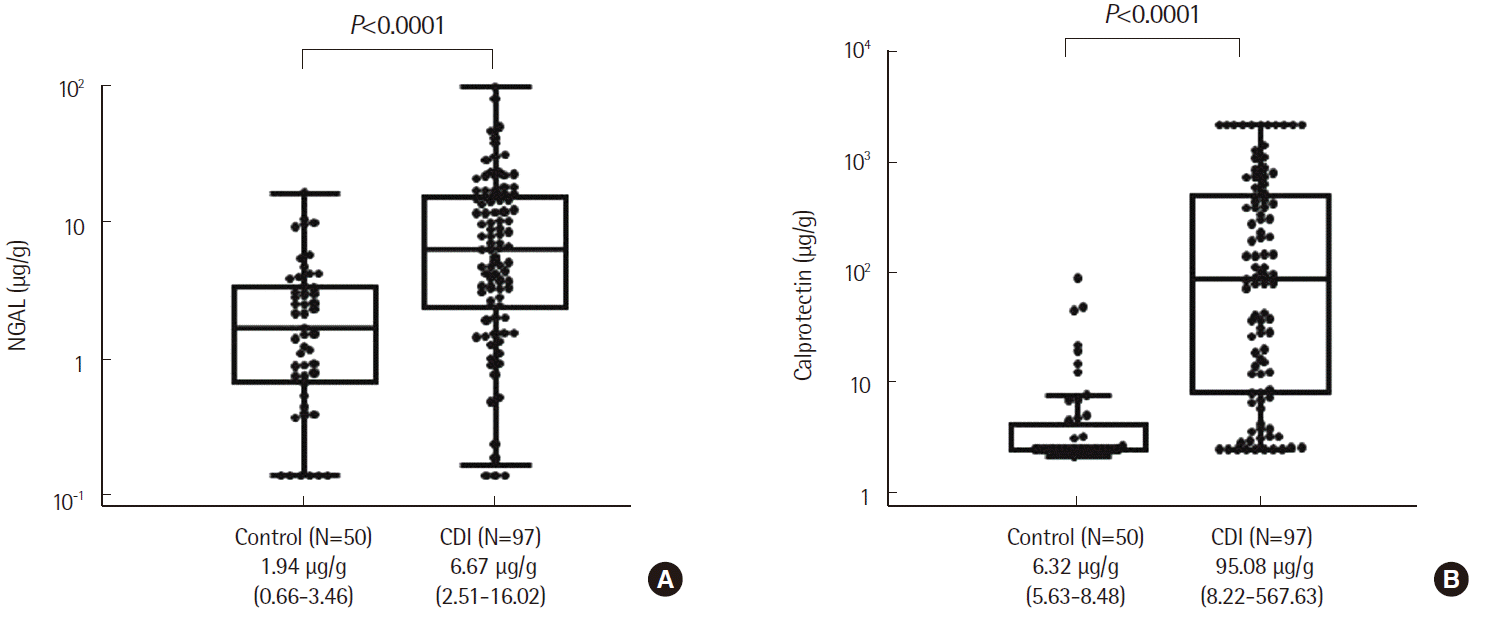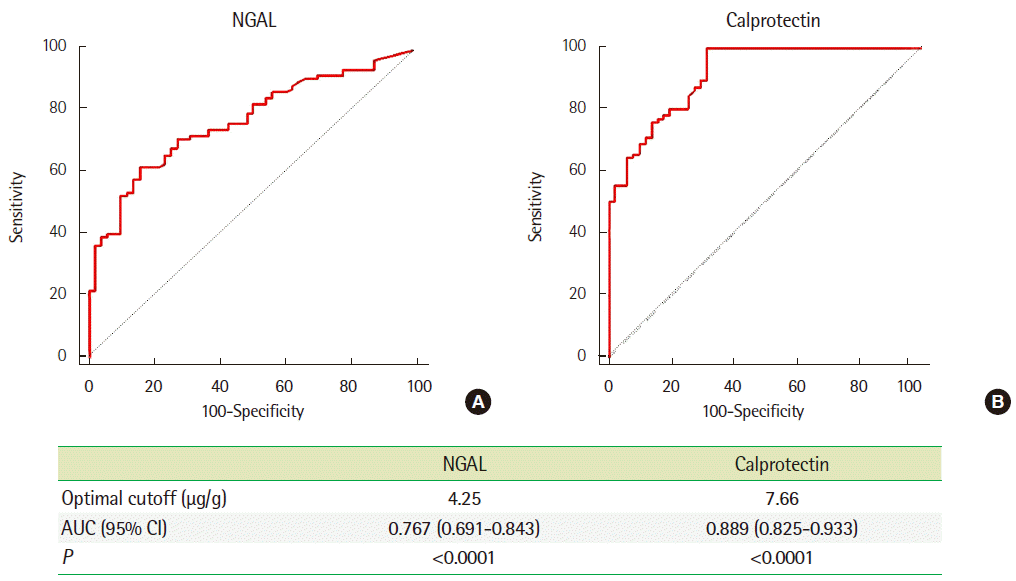1. Lawson PA, Citron DM, Tyrrell KL, Finegold SM. 2016; Reclassification of
Clostridium difficile as
Clostridioides difficile (Hall and O'Toole 1935) Prévot 1938. Anaerobe. 40:95–9. DOI:
10.1016/j.anaerobe.2016.06.008. PMID:
27370902.
2. Balsells E, Shi T, Leese C, Lyell I, Burrows J, Wiuff C, et al. 2019; Global burden of
Clostridium difficile infections: a systematic review and meta-analysis. J Glob Health. 9:010407. DOI:
10.7189/jogh.09.010407. PMID:
30603078. PMCID:
PMC6304170.

3. McDonald LC, Gerding DN, Johnson S, Bakken JS, Carroll KC, Coffin SE, et al. 2018; Clinical practice guidelines for
Clostridium difficile infection in adults and children: 2017 Update by the Infectious Diseases Society of America (IDSA) and Society for Healthcare Epidemiology of Amer-ica (SHEA). Clin Infect Dis. 66:987–94. DOI:
10.1093/cid/ciy149. PMID:
29562266.
4. Senchyna F, Gaur RL, Gombar S, Truong CY, Schroeder LF, Banaei N. 2017;
Clostridium difficile PCR cycle threshold predicts free toxin. J Clin Mi-crobiol. 55:2651–60. DOI:
10.1128/JCM.00563-17. PMID:
28615471. PMCID:
PMC5648702.
5. Manceau H, Chicha-Cattoir V, Puy H, Peoc'h K. 2017; Fecal calprotectin in inflammatory bowel diseases: update and perspectives. Clin Chem Lab Med. 55:474–83. DOI:
10.1515/cclm-2016-0522. PMID:
27658156.

6. Thorsvik S, Damås JK, Granlund AV, Flo TH, Bergh K, Østvik AE, et al. 2017; Fecal neutrophil gelatinase-associated lipocalin as a biomarker for inflammatory bowel disease. J Gastroenterol Hepatol. 32:128–35. DOI:
10.1111/jgh.13598. PMID:
27640344.

7. Budzynska A, Gawron-Kiszka M, Nowakowska-Dulawa E, Spiewak J, Lesinska M, Kukla M, et al. 2017; Serum neutrophil gelatinase-associated lipocalin (NGAL) correlates with clinical and endoscopic activity in ulcerative colitis but fails to predict activity in Crohn's disease. J Physiol Pharmacol. 68:859–65. PMID:
29550798.
8. Foster AJ, Smyth M, Lakhani A, Jung B, Brant RF, Jacobson K. 2019; Consecutive fecal calprotectin measurements for predicting relapse in pediat-ric Crohn's disease patients. World J Gastroenterol. 25:1266–77. DOI:
10.3748/wjg.v25.i10.1266. PMID:
30886509. PMCID:
PMC6421242.

9. Barbut F, Gouot C, Lapidus N, Suzon L, Syed-Zaidi R, Lalande V, et al. 2017; Faecal lactoferrin and calprotectin in patients with
Clostridium difficile infection: a case-control study. Eur J Clin Microbiol Infect Dis. 36:2423–30. DOI:
10.1007/s10096-017-3080-y. PMID:
28801865.
10. Swale A, Miyajima F, Roberts P, Hall A, Little M, Beadsworth MB, et al. 2014; Calprotectin and lactoferrin faecal levels in patients with
Clostridium difficile infection (CDI): A prospective cohort study. PLoS One. 9:e106118. DOI:
10.1371/journal.pone.0106118. PMID:
25170963. PMCID:
PMC4149523.
12. Debast SB, Bauer MP, Kuijper EJ. 2014; European Society of Clinical Microbiology and Infectious Diseases: update of the treatment guidance document for
Clostridium difficile infection. Clin Microbiol Infect. 20:1–26. DOI:
10.1111/1469-0691.12418. PMID:
24118601.
15. Sipponen T and Kolho KL. 2015; Fecal calprotectin in diagnosis and clinical assessment of inflammatory bowel disease. Scand J Gastroenterol. 50:74–80. DOI:
10.3109/00365521.2014.987809. PMID:
25523558.
16. Singer E, Markó L, Paragas N, Barasch J, Dragun D, Müller DN, et al. 2013; Neutrophil gelatinase-associated lipocalin: pathophysiology and clinical applications. Acta Physiol (Oxf). 207:663–72. DOI:
10.1111/apha.12054. PMID:
23375078. PMCID:
PMC3979296.

17. Nakashige TG, Zhang B, Krebs C, Nolan EM. 2015; Human calprotectin is an iron-sequestering host-defense protein. Nat Chem Biol. 11:765–71. DOI:
10.1038/nchembio.1891. PMID:
26302479. PMCID:
PMC4575267.

18. Zhang A, Cai Y, Wang PF, Qu JN, Luo ZC, Chen XD, et al. 2016; Diagnosis and prognosis of neutrophil gelatinase-associated lipocalin for acute kidney injury with sepsis: a systematic review and meta-analysis. Crit Care. 20:41. DOI:
10.1186/s13054-016-1212-x. PMID:
26880194. PMCID:
PMC4754917.

19. D'Angelo F, Felley C, Frossard JL. 2017; Calprotectin in daily practice: Where do we stand in 2017? Digestion. 95:293–301. DOI:
10.1159/000476062. PMID:
28511188.
20. He T, Kaplan SE, Gomez LA, Lu X, Ramanathan LV, Kamboj M, et al. 2018; Fecal calprotectin concentrations in cancer patients with
Clostridium difficile infection. Eur J Clin Microbiol Infect Dis. 37:2341–6. DOI:
10.1007/s10096-018-3381-9. PMID:
30242543. PMCID:
PMC6230305.
21. Rao K, Santhosh K, Mogle JA, Higgins PD, Young VB. 2016; Elevated fecal calprotectin associates with adverse outcomes from
Clostridium difficile infection in older adults. Infect Dis (Lond). 48:663–9. DOI:
10.1080/23744235.2016.1186832. PMID:
27206404. PMCID:
PMC4951100.
22. Cho SY, Nam Y, Soh YS, Park TS, Lee HJ. 2014; To the editor: Molecular epidemiology of toxigenic
Clostridium difficile isolates in Korea. Epide-miol Infect. 142:1651–2. DOI:
10.1017/S0950268813003051. PMID:
24290036.
23. Davies KA, Longshaw C, Davis GL, Bouza E, Barbut F, Barna Z, et al. 2014; Underdiagnosis of
Clostridium difficile across Europe: the European, multicentre, prospective, biannual, point-prevalence study of
Clostridium difficile infection in hospitalised patients with diarrhoea (EUCLID). Lancet Infect Dis. 14:1208–19. DOI:
10.1016/S1473-3099(14)70991-0.
24. Valiente E, Cairns MD, Wren BW. 2014; The
Clostridium difficile PCR ribotype 027 lineage: a pathogen on the move. Clin Microbiol Infect. 20:396–404. DOI:
10.1111/1469-0691.12619. PMID:
24621128.
25. Gallo A, Vallone C, Sabatelli L, Ventura G, Covino M, Cammarota G, et al. 2018; Fecal calprotectin in management of
Clostridium difficile infection: a longitudinal study. Scand J Gastroenterol. 53:567–72. DOI:
10.1080/00365521.2017.1392598. PMID:
29065739.
26. Popiel KY, Gheorghe R, Eastmond J, Miller MA. 2015; Usefulness of adjunctive fecal calprotectin and serum procalcitonin in individuals positive for
Clostridium difficile toxin gene by PCR assay. J Clin Microbiol. 53:3667–9. DOI:
10.1128/JCM.02230-15. PMID:
26354814. PMCID:
PMC4609681.
27. Peretz A, Tkhawkho L, Pastukh N, Brodsky D, Halevi CN, Nitzan O. 2016; Correlation between fecal calprotectin levels, disease severity and the hypervirulent ribotype 027 strain in patients with
Clostridium difficile infection. BMC Infect Dis. 16:309. DOI:
10.1186/s12879-016-1618-8. PMID:
27334992. PMCID:
PMC4918013.





 PDF
PDF Citation
Citation Print
Print




 XML Download
XML Download